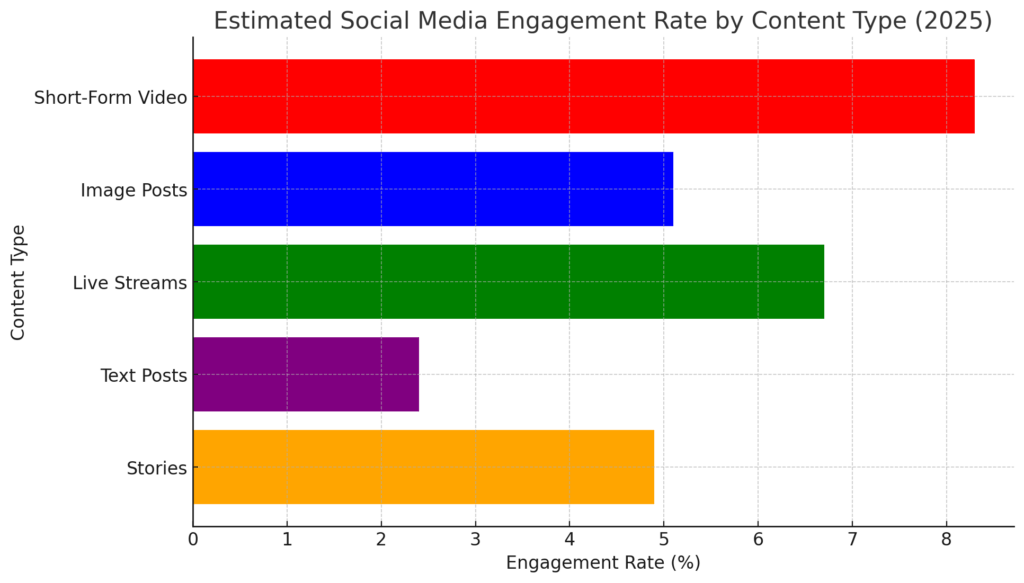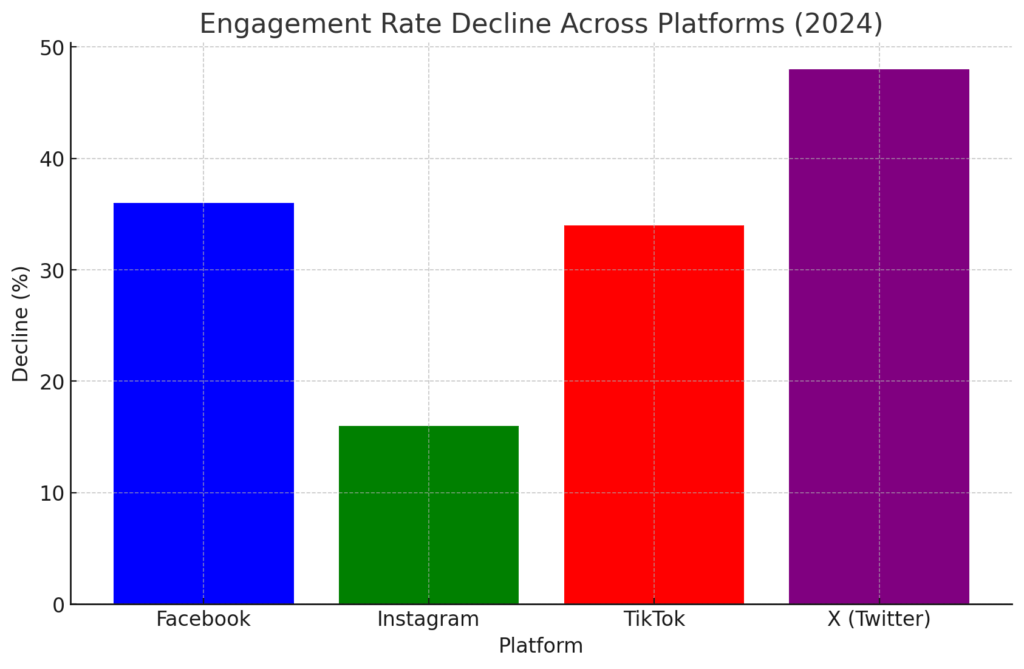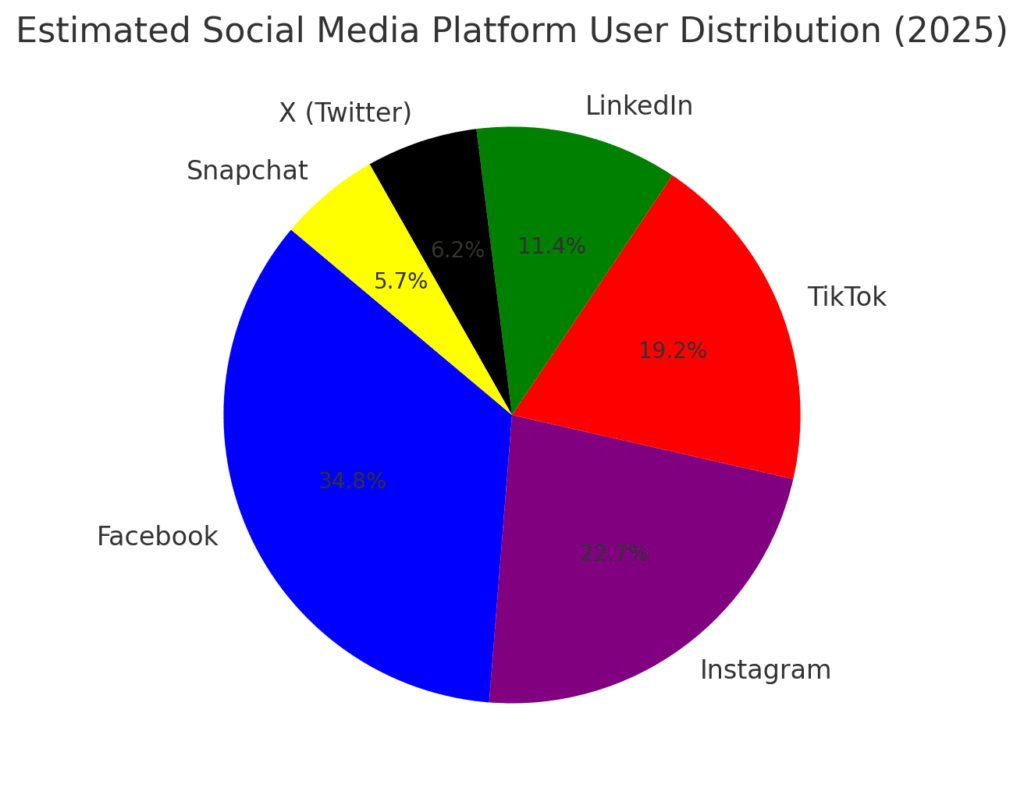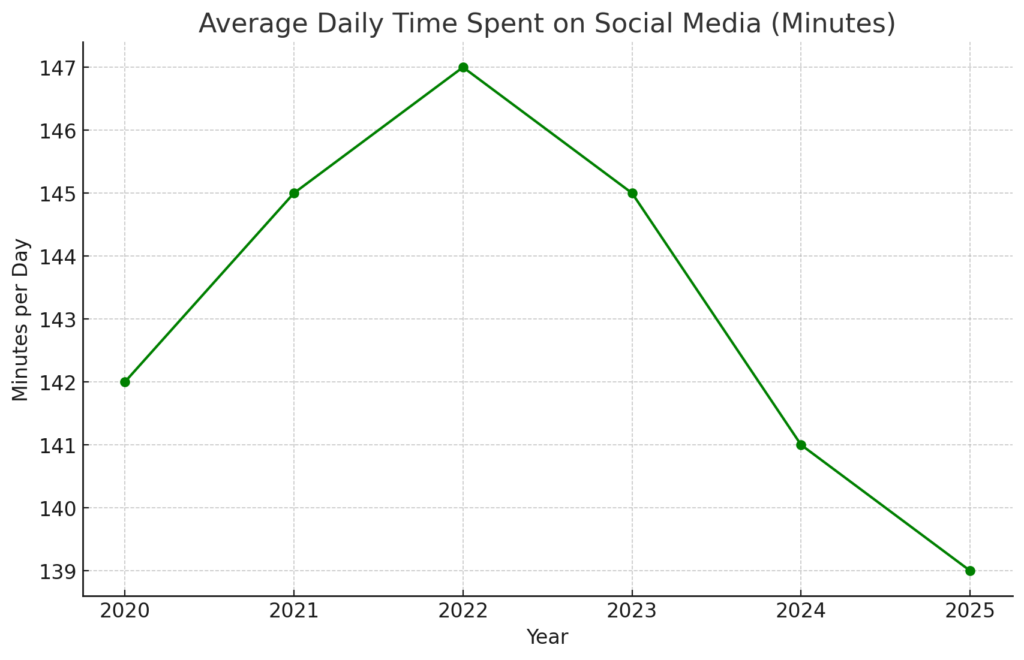
08 Mar TOP SOCIAL MEDIA ENGAGEMENT STATISTICS 2025
Social media engagement has evolved dramatically over the years, shaping how people interact, consume content, and make purchasing decisions. As we move through 2025, new trends are emerging, redefining user behavior and influencing how businesses approach digital marketing. From the explosive rise of short-form video to the increasing demand for real-time brand interactions, engagement patterns are shifting in ways that brands can’t afford to ignore. Social platforms are no longer just spaces for connection—they’re powerful marketplaces, trendsetters, and customer service hubs. With billions of users engaging daily across multiple platforms, Amra and Elma aims to understand these trends to help brands stay relevant. The following 20 statistics reveal surprising insights into social media engagement, highlighting where user behavior is headed and what it means for the future of digital marketing
TOP SOCIAL MEDIA ENGAGEMENT STATISTICS 2025 (Editor’s Choice)
Here are 20 top social media engagement statistics, reflecting both general trends over time and projections for 2025:
1. Global Social Media Users: As of January 2025, there are 5.24 billion social media users worldwide, accounting for 63.9% of the global population.
2. Average Platforms Per User: The typical social media user engages with 6.8 different platforms each month.
3. Daily Usage Time: On average, individuals spend 2 hours and 21 minutes per day on social media, amounting to approximately 14% of their waking hours.
4. Annual User Growth: Over the past year, social media platforms have welcomed 206 million new users, indicating an annual growth rate of 4.1%.
5. Mobile Access Dominance: A staggering 91% of social media users access platforms via mobile devices.
6. Video Content Preference: Short-form videos, typically under 90 seconds, generate more than twice the engagement of longer videos.
7. Influence on Purchasing Decisions: Approximately 73% of consumers use short videos for product research, highlighting their impact on purchasing decisions.
8. Advertising Revenue from Short Videos: Short-form video ads are projected to generate over $99 billion in revenue by the end of 2024.
9. Facebook’s Active Users: Facebook remains the largest social network, boasting 3.07 billion monthly active users as of October 2024.
10. Instagram Stories Usage: Over 500 million people use Instagram Stories daily, emphasizing the popularity of ephemeral content.
11. TikTok’s Rapid Growth: TikTok has reached 1.69 billion monthly active users, making it one of the fastest-growing platforms.
12. LinkedIn’s Professional Reach: LinkedIn’s advertising reach now encompasses 12.7% of the world’s population, solidifying its position as a leading professional network.
13. Social Media Advertising Spend: Global social media advertising expenditure is projected to reach $276.7 billion in 2025.
14. Mobile Ad Revenue Share: By 2030, it’s anticipated that 83% of total social media ad spending will be generated through mobile devices.
15. Consumer-Brand Interaction Increase: Nearly half (48%) of consumers reported interacting with brands more frequently on social media than six months prior.
16. Role in Trend Awareness: Approximately 90% of consumers rely on social media to stay updated on trends and cultural moments.
17. Decline in Daily Usage: The average daily time spent on social media has slightly declined to 141 minutes per day.
18. Social Media’s Share of Digital Advertising: Social media ads account for 30% of all digital advertising expenditures.
19. Consumer Trust and Responsiveness: Around 73% of social media users expect a brand to respond within 24 hours; failure to do so may lead them to seek alternatives.
20. Impact on Impulse Purchases: Approximately 81% of consumers say social media compels them to make spontaneous purchases multiple times per year or more, with 28% making impulse purchases once a month.
These statistics underscore the evolving landscape of social media engagement, highlighting the increasing importance of mobile access, video content, and timely brand interactions in 2025.

TOP SOCIAL MEDIA ENGAGEMENT STATISTICS 2025 and Future Implications
TOP SOCIAL MEDIA ENGAGEMENT STATISTICS #1. Global Social Media Users (5.24 billion in 2025):
The number of social media users continues to grow, with 5.24 billion people worldwide now active on platforms. This widespread adoption shows that social media is no longer an optional tool for businesses but a necessity for brand visibility. As more people join these platforms, competition for attention will intensify, making personalized and engaging content more valuable than ever. The growth also signals the increasing digitalization of emerging markets, which could shift social media trends and advertising priorities. Companies expanding globally should consider localized marketing strategies to appeal to these newer users. Additionally, governments may introduce more regulations to protect user data and privacy, influencing how brands interact with audiences. In the long run, this surge in users suggests that social media will remain a dominant force in shaping consumer behavior and digital interactions.
TOP SOCIAL MEDIA ENGAGEMENT STATISTICS #2. Average Platforms Per User (6.8 platforms per month):
People are engaging with nearly seven different social media platforms every month, highlighting the fragmented nature of digital interaction. This trend suggests that brands cannot rely on just one platform to reach their audience effectively. Instead, they must develop multi-platform strategies that cater to different content preferences, whether it’s short-form videos on TikTok or professional updates on LinkedIn. Consumers switching between platforms also means they expect seamless brand messaging across channels. Businesses that fail to create a cohesive cross-platform presence risk losing engagement to competitors that do. Marketers should focus on repurposing content effectively rather than merely duplicating posts across platforms. This shift emphasizes the growing need for adaptable content strategies tailored to diverse audience behaviors.
TOP SOCIAL MEDIA ENGAGEMENT STATISTICS #3. Daily Usage Time (2 hours, 21 minutes per day):
Spending over two hours daily on social media means these platforms hold significant influence over consumers’ decision-making and daily routines. With this level of engagement, brands have more opportunities to capture attention, but they must also compete with an overwhelming amount of content. Algorithms are prioritizing high-quality and interactive content, making engaging videos, live streams, and authentic storytelling essential for standing out. Users’ screen time also indicates a continued shift toward mobile browsing and app-based engagement. This reliance on social media for entertainment, news, and shopping means businesses should focus on optimizing their mobile experience. With attention spans shrinking, content that quickly delivers value—whether through humor, education, or inspiration—will be more effective. In the long term, social media’s role in daily life is likely to deepen, further integrating with e-commerce, virtual experiences, and even work-related interactions.
TOP SOCIAL MEDIA ENGAGEMENT STATISTICS #4. Annual User Growth (206 million new users in one year):
Social media is still growing rapidly, adding 206 million users in just a year. This growth rate shows that there’s still untapped potential in regions where digital access is expanding. Brands looking to scale should pay attention to emerging markets, particularly in Africa, South Asia, and Latin America, where adoption rates are accelerating. More users mean more data being generated, leading to better ad targeting and personalization. However, it also raises concerns about data privacy and misinformation, which could lead to stricter regulations worldwide. The increasing number of users also means that brands have more opportunities to engage with diverse demographics, requiring them to create content that resonates across cultural and generational lines. This expansion indicates that social media’s influence is far from peaking, and businesses must stay agile to keep up with changing audience expectations.
TOP SOCIAL MEDIA ENGAGEMENT STATISTICS #5. Mobile Access Dominance (91% of users on mobile):
With 91% of users accessing social media via mobile devices, brands must prioritize mobile-first strategies. Websites and ads need to be optimized for smaller screens, with fast load times and easy navigation to prevent drop-offs. Vertical video formats like TikTok and Instagram Reels are gaining traction, making them essential for brands looking to increase engagement. The dominance of mobile also means that users expect quick interactions, from instant replies in DMs to seamless in-app purchases. This reliance on mobile could lead to more AI-driven experiences, such as chatbots handling customer service inquiries in real-time. Additionally, mobile-heavy usage strengthens the case for location-based advertising, where brands can target users based on their physical proximity to stores. As 5G technology expands, mobile social media experiences will become even more immersive, integrating AR and interactive elements into everyday scrolling habits.

TOP SOCIAL MEDIA ENGAGEMENT STATISTICS #6. Video Content Preference (Short-form videos generate 2x engagement):
Short-form videos now generate twice the engagement of longer ones, proving that quick, digestible content is the future. Platforms like TikTok, Instagram Reels, and YouTube Shorts have conditioned audiences to expect snappy, visually appealing videos that deliver instant value. Brands that fail to adapt risk losing relevance, as traditional static posts no longer capture attention the same way. This trend also suggests that storytelling must evolve to fit shorter timeframes, making strong hooks and immediate engagement more critical than ever. Marketers should focus on behind-the-scenes content, customer testimonials, and interactive videos to maximize engagement. The rise of AI-generated video content may also allow brands to produce more personalized and scalable video experiences. Moving forward, companies that integrate short-form videos into their strategy will likely see higher audience retention and conversion rates.
TOP SOCIAL MEDIA ENGAGEMENT STATISTICS #7. Influence on Purchasing Decisions (73% use short videos for product research):
The fact that 73% of consumers use short videos for product research means that video content is becoming a key driver of sales. Unboxing videos, quick tutorials, and influencer testimonials are shaping purchasing decisions more than traditional ads. This shift suggests that brands must invest in video production, ensuring their products are showcased in an engaging and authentic way. Consumers now expect to see real-world applications of products before making a purchase, which is why live demonstrations and user-generated content are gaining traction. Additionally, the trust placed in video content means that brands with poor visual storytelling will struggle to convert viewers into buyers. AI-powered video recommendations could further personalize shopping experiences, enhancing engagement and customer satisfaction. As e-commerce continues integrating with social media, short videos will likely become the primary tool for product discovery.
TOP SOCIAL MEDIA ENGAGEMENT STATISTICS #8. Advertising Revenue from Short Videos ($99 billion in 2024):
Short-form video ads are projected to generate nearly $100 billion in revenue, proving their dominance in digital marketing. This surge in spending means that advertisers see these formats as highly effective in capturing audience attention and driving conversions. Platforms like TikTok, YouTube Shorts, and Instagram Reels are leading the charge, with brands reallocating budgets from traditional digital ads to video-first campaigns. The high ROI of these ads suggests that interactive, immersive content is the future of advertising. However, the competition for prime ad space within short videos will drive up costs, making creative differentiation even more important. Marketers must focus on storytelling that resonates quickly and leverages trends without feeling forced. As social commerce expands, the ability to purchase directly from short-form video ads will make them even more valuable for brands looking to drive impulse buys.
TOP SOCIAL MEDIA ENGAGEMENT STATISTICS #9. Facebook’s Active Users (3.07 billion monthly):
Facebook remains the largest social media platform, with over 3 billion active users, proving its resilience despite rising competition. While younger audiences are gravitating toward TikTok and Instagram, Facebook remains dominant due to its established communities, groups, and marketplace features. This stability means brands cannot afford to ignore Facebook, especially for reaching older demographics and international markets where it remains highly popular. Its advanced advertising tools, including hyper-targeted ads and AI-driven content recommendations, make it a powerful platform for businesses. However, engagement patterns have shifted, with users spending more time in private groups and on video content rather than traditional feed posts. Brands need to focus on fostering niche communities and leveraging Facebook Live, Reels, and Stories to stay relevant. As Meta continues integrating AI and VR into Facebook, engagement strategies will need to evolve toward more immersive digital experiences.
TOP SOCIAL MEDIA ENGAGEMENT STATISTICS #10. Instagram Stories Usage (500 million daily users):
Instagram Stories remain one of the most popular engagement tools, with half a billion people using them daily. This format has transformed how brands connect with audiences, offering ephemeral content that feels personal and urgent. The 24-hour lifespan of Stories encourages real-time interaction, making it an ideal space for promotions, behind-the-scenes content, and interactive elements like polls and Q&A sessions. As social commerce grows, Instagram’s shopping features within Stories have made it easier for brands to convert views into sales. Businesses that fail to leverage Stories risk being overshadowed by competitors who engage audiences with more dynamic content. With the rise of AI-driven personalization, Stories could become even more tailored to individual users, increasing engagement rates. Looking ahead, brands will need to balance organic content with strategic paid promotions to maximize visibility in this highly competitive space.

TOP SOCIAL MEDIA ENGAGEMENT STATISTICS #11. TikTok’s Rapid Growth (1.69 billion monthly users):
TikTok’s explosive growth has cemented it as one of the most influential platforms for social media engagement. With nearly 1.7 billion users, TikTok is redefining content consumption with its algorithm-driven, hyper-personalized video feed. Unlike traditional social media, TikTok prioritizes content over follower count, allowing smaller brands and creators to go viral overnight. This levels the playing field, making it an essential platform for businesses looking to increase visibility quickly. However, TikTok’s rapid growth has also led to increased scrutiny over data privacy and potential regulatory challenges. Brands must navigate these concerns while leveraging TikTok’s unique trends, challenges, and influencer partnerships to maintain relevance. As TikTok continues integrating shopping features, its role in e-commerce will likely expand, making it a crucial platform for product discovery and impulse purchases.
TOP SOCIAL MEDIA ENGAGEMENT STATISTICS #12. LinkedIn’s Professional Reach (12.7% of global population):
LinkedIn’s advertising reach now covers nearly 13% of the world’s population, reinforcing its status as the premier platform for professional networking. Unlike other social media sites, LinkedIn thrives on thought leadership, career growth, and B2B interactions. This reach makes it a powerful tool for recruitment, industry networking, and high-value marketing campaigns targeting professionals. The platform’s shift toward video content, newsletters, and interactive posts signals that engagement strategies must evolve beyond static updates. As remote work and digital networking grow, LinkedIn’s importance in connecting professionals worldwide will only increase. Brands that focus on authentic storytelling, employee advocacy, and value-driven content will see the most engagement. Looking forward, AI-driven job matching and skill-based networking could further enhance LinkedIn’s role in career development and professional branding.
TOP SOCIAL MEDIA ENGAGEMENT STATISTICS #13. Social Media Advertising Spend ($276.7 billion in 2025):
Global social media ad spend is projected to surpass $276 billion in 2025, highlighting the growing reliance on digital marketing. This increase reflects brands’ shifting budgets from traditional media to social-first campaigns, where targeting and engagement are more precise. The rising cost of advertising on platforms like Instagram, TikTok, and LinkedIn means marketers must optimize ad creatives and audience segmentation to maximize ROI. AI-driven ad personalization will continue to play a key role, allowing brands to serve highly relevant content to users. However, growing concerns over ad fatigue and privacy regulations may push marketers to explore organic engagement strategies alongside paid efforts. As competition intensifies, brands that blend creative storytelling with data-driven insights will outperform those relying on generic ad placements. Looking ahead, immersive ad formats, including AR and interactive content, will likely shape the future of social media marketing.
TOP SOCIAL MEDIA ENGAGEMENT STATISTICS #14. Mobile Ad Revenue Share (83% by 2030):
By 2030, mobile devices will generate 83% of all social media ad revenue, underscoring the dominance of mobile-first experiences. This trend aligns with the fact that most users now access social platforms exclusively through their phones. For marketers, this means prioritizing mobile-friendly content, including vertical videos, interactive ads, and click-to-shop features. The rise of AI-driven ad delivery will allow brands to target users with extreme precision based on browsing habits and in-app behavior. As mobile technology advances, features like augmented reality (AR) and voice search will become integral to digital advertising. Businesses that fail to optimize for mobile may struggle to compete in an ecosystem where quick, seamless interactions drive conversions. Moving forward, 5G and foldable devices could further reshape how users engage with social media ads, making adaptive content strategies essential.
TOP SOCIAL MEDIA ENGAGEMENT STATISTICS #15. Consumer-Brand Interaction Increase (48% engage more than six months ago):
Nearly half of social media users report increased interactions with brands compared to six months ago, highlighting a shift toward more direct digital engagement. This growth suggests that consumers now expect real-time responses, personalized experiences, and meaningful brand interactions. Social media is no longer just a broadcasting tool—it’s a two-way communication channel where engagement drives brand loyalty. AI-powered chatbots and automated customer service responses will continue to rise, helping brands keep up with consumer expectations. However, businesses that rely too heavily on automation without maintaining a human touch may risk alienating customers. Brands that foster genuine conversations and community-building will see stronger retention rates than those focused solely on promotions. As engagement continues rising, companies must balance automation with personalized interactions to sustain meaningful connections.

TOP SOCIAL MEDIA ENGAGEMENT STATISTICS #16. Role in Trend Awareness (90% use social media for trends):
A staggering 90% of consumers rely on social media to stay informed about trends, making it the go-to source for cultural and industry shifts. This statistic shows that platforms like TikTok, Instagram, and Twitter now set the pace for everything from fashion to financial markets. Brands that stay ahead of emerging trends can capitalize on viral moments and position themselves as industry leaders. However, with trends shifting rapidly, marketers must develop agile content strategies that allow for quick adaptation. The influence of social media on trends also means misinformation can spread faster, requiring brands to be vigilant about credibility. AI-powered trend analysis tools could help businesses predict emerging interests and adjust their marketing strategies proactively. As user-generated content continues shaping trends, brands should focus on collaboration with creators to maintain cultural relevance.
TOP SOCIAL MEDIA ENGAGEMENT STATISTICS #17. Decline in Daily Usage (141 minutes per day):
Despite high engagement levels, the average daily time spent on social media has slightly declined, now standing at 141 minutes per day. This suggests that users may be experiencing content fatigue or becoming more selective with their screen time. As a result, brands must focus on quality over quantity, ensuring each post delivers value rather than contributing to digital noise. The decline could also indicate that audiences are diversifying their online activities, engaging more with streaming platforms, gaming, or private messaging apps. Marketers may need to rethink their strategies, shifting from broad content distribution to targeted micro-communities where engagement is deeper. This change also underscores the importance of retention tactics, such as gamification, interactive content, and exclusive member perks. Looking ahead, social media platforms may introduce new engagement tools to counteract this trend and keep users active longer.
TOP SOCIAL MEDIA ENGAGEMENT STATISTICS #18. Social Media’s Share of Digital Advertising (30% of all digital ad spend):
Social media advertising now accounts for 30% of all digital ad spending, solidifying its role as a primary driver of online marketing. This figure highlights the shift from traditional search and display ads to highly targeted, interactive social ads that engage users in their preferred digital spaces. With platforms like TikTok, Instagram, and LinkedIn continuously refining their ad tools, businesses have more options to reach their ideal audience with precision. However, with rising competition, ad costs are increasing, making it essential for brands to optimize their creatives and audience segmentation. The growing share of social media in ad budgets also suggests that brands must prioritize platform-specific strategies rather than using a one-size-fits-all approach. Additionally, privacy concerns and ad-blocking technology may challenge advertisers, forcing them to rely more on organic engagement and influencer partnerships. Looking ahead, AI-driven ad personalization and immersive formats like augmented reality (AR) ads will likely dominate the space.
TOP SOCIAL MEDIA ENGAGEMENT STATISTICS #19. Consumer Trust and Responsiveness (73% expect brands to reply within 24 hours):
With 73% of users expecting brands to respond within 24 hours, customer service on social media has become a key factor in maintaining trust and loyalty. Consumers now view social media as an extension of customer support, expecting immediate and personalized assistance through direct messages and comments. This shift means businesses must invest in social listening tools, chatbots, and dedicated support teams to keep up with demand. Delayed or unresponsive interactions can lead to negative reviews, lost sales, and decreased brand reputation. AI-powered customer service is helping companies manage high volumes of inquiries, but automation alone isn’t enough—authentic human interaction is still critical for complex issues. As consumer expectations continue rising, brands that excel in real-time engagement will gain a competitive edge. In the future, instant responses powered by AI and predictive customer service tools will become the norm, setting a higher bar for brand accountability.
TOP SOCIAL MEDIA ENGAGEMENT STATISTICS #20. Impact on Impulse Purchases (81% make spontaneous purchases via social media):
The fact that 81% of consumers admit to making impulse purchases through social media underscores the platform’s growing role in driving direct sales. Features like Instagram Shopping, TikTok Shop, and Facebook Marketplace make it easier than ever for users to buy products directly within their feeds. This statistic signals a shift from social media as a brand-awareness tool to a full-fledged e-commerce engine. The combination of influencer recommendations, shoppable posts, and personalized ads creates a seamless purchase journey that encourages spontaneous spending. Businesses must capitalize on this by optimizing their product visuals, simplifying checkout processes, and integrating AI-driven recommendations. However, with impulse buying on the rise, brands must also focus on ethical marketing practices to build long-term trust. Looking forward, social commerce will likely expand further, with innovations like live shopping and AI-powered virtual try-ons enhancing the consumer experience.
Sources:
- https://datareportal.com/social-media-users
- https://datareportal.com/social-media-users
- https://datareportal.com/social-media-users
- https://datareportal.com/social-media-users
- https://thesocialshepherd.com/blog/social-media-statistics
- https://www.lifewire.com/short-video-marketing-8724125
- https://www.lifewire.com/short-video-marketing-8724125
- https://www.lifewire.com/short-video-marketing-8724125
- https://statusbrew.com/insights/social-media-statistics
- https://thesocialshepherd.com/blog/social-media-statistics
- https://statusbrew.com/insights/social-media-statistics
- https://recurpost.com/blog/social-media-statistics/
- https://sproutsocial.com/insights/social-media-statistics/
- https://sproutsocial.com/insights/social-media-statistics/
- https://sproutsocial.com/insights/social-media-statistics/
- https://sproutsocial.com/insights/social-media-statistics/
- https://sproutsocial.com/insights/social-media-statistics/
- https://sproutsocial.com/insights/social-media-statistics/
- https://sproutsocial.com/insights/social-media-statistics/
- https://sproutsocial.com/insights/social-media-statistics/

